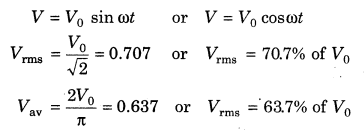Notes For All Chapters Physics Class 12 CBSE
1. Alternating Current (AC) It is the current which varies in both magnitude as well as direction alternatively and periodically.
I = I0 sin ωt or I = I0 cosωt where, I0 = peak value or maximum value of AC.
2. Effective Value or rms Value of AC It is defined as the value of AC over a complete cycle which would generate same amount of heat in a given resistors that is generated by steady current in the same resistor and in the same time during a complete cycle.
The 70.7% of peak value of current gives effective or rms value of AC.
3. Average or Mean Value of AC It is defined as the value of AC which would send same amount of charge through a circuit in half-cycle that is sent by steady current in the same time.
The 63.7% of peak value of AC gives average or mean value of AC.
NOTE: In a complete cycle of AC, the mean value of AC will be zero.
4. Alternating emf or Voltage It is the emf which varies in both magnitude as well as direction alternatively and periodically. The instantaneous alternating emf is given by
Both AC voltage and AC current are represented by diagrams as shown below:
5. Inductive Reactance (XL) The opposing nature of inductor to the flow of current is called Inductive reactance.
6. Capacitive Reactance (Xc) The opposing nature of capacitor to the flow of alternating current is called capacitive reactance.
7. Power In an AC circuit, both emf and current change continuously w.r.t. time, so in circuit, we have to calculate average power in complete cycle (0 –> T).
8. Average power consumption in pure inductive and pure capacitive circuit is equal to zero because
9. Wattless Current The current in an AC circuit when average power consumption in AC circuit is zero, is referred as wattless current or idle current.








Leave a Reply